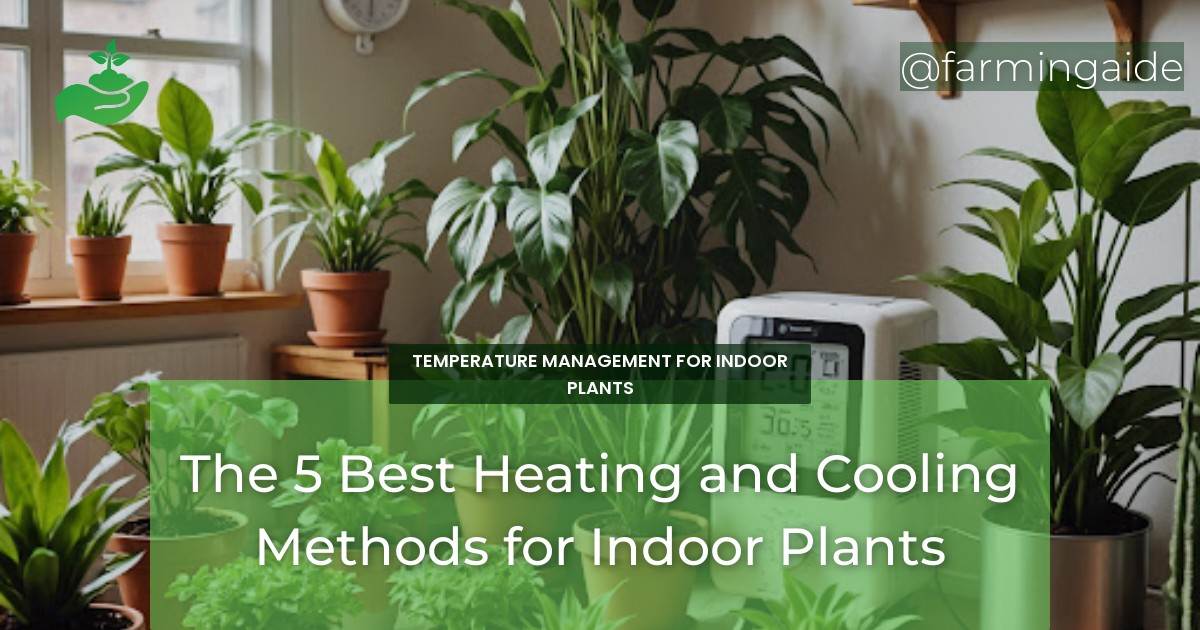As indoor plant enthusiasts, we know that maintaining the perfect temperature is crucial for our plants’ health and growth. However, with so many heating and cooling methods available, it can be overwhelming to choose the right one for our plants. In this article, we’ll explore the top 5 heating and cooling methods for indoor plants, and provide you with a comprehensive guide to help you make an informed decision.
Key Takeaways
- Understand the optimal temperature ranges for indoor plants
- Learn about the top 5 heating methods for indoor plants
- Discover the top 5 cooling methods for indoor plants
- Find out how to integrate heating and cooling systems for optimal plant care
- Get tips on energy efficiency and installation and maintenance
Introduction to Indoor Plant Temperature Needs
Indoor plants have specific temperature requirements to thrive. The ideal temperature range for most indoor plants falls between 65°F to 75°F (18°C to 24°C). However, some plants may require more precise temperature control. For instance, orchids prefer temperatures between 55°F to 65°F (13°C to 18°C), while succulents can tolerate temperatures up to 85°F (29°C).
Temperature control is crucial for plant growth, as it affects photosynthesis, respiration, and transpiration. A slight deviation from the optimal temperature range can lead to stress, disease, and even death. Understanding the specific temperature needs of your plants is essential for providing optimal care.
Understanding Optimal Temperature Ranges for Indoor Plants
The optimal temperature range for indoor plants varies depending on the species, growth stage, and environmental conditions. Most plants grow best in temperatures between 65°F to 75°F (18°C to 24°C), with some exceptions:
| Plant Type | Optimal Temperature Range (°F) |
|---|---|
| Tropical Plants | 75°F – 85°F (24°C – 29°C) |
| Succulents | 65°F – 85°F (18°C – 29°C) |
| Orchids | 55°F – 65°F (13°C – 18°C) |
The Importance of Temperature Control for Plant Health
Maintaining the optimal temperature range is vital for plant health. Temperature fluctuations can lead to:
- Reduced growth and development
- Increased susceptibility to disease and pests
- Water stress and nutrient deficiencies
- Reduced photosynthesis and respiration
Top 5 Heating Methods for Indoor Plants
Heating methods for indoor plants come in various forms, each with its advantages and disadvantages. Here are the top 5 heating methods for indoor plants:
ALSO READ
Space Heaters: A Versatile Solution
Space heaters are a popular choice for indoor plants, as they provide localized heat and can be easily moved around. Look for energy-efficient models with thermostatic controls to maintain optimal temperatures.
When using space heaters, ensure they are placed at a safe distance from plants to avoid burning or scorching.
Heating Mats: Ideal for Root Temperature Control
Heating mats are designed to warm the soil, providing optimal root temperature control. They are ideal for plants that require warmer roots, such as tropical species.
Heating mats are energy-efficient and can be placed under pots or in greenhouses.
ALSO READ
Ceramic Heaters: Safe and Efficient
Ceramic heaters are a safe and efficient option for indoor plants. They emit gentle heat, making them ideal for plants that require a consistent temperature.
Look for ceramic heaters with thermostatic controls to maintain optimal temperatures.
Infrared Heaters: Direct Heat for Plant Growth
Infrared heaters provide direct heat, which can be beneficial for plants that require a boost in growth.
However, be cautious when using infrared heaters, as they can cause overheating if not monitored.
Invest in thermostatic controls that can be programmed to maintain a specific temperature range.
Top 5 Cooling Methods for Indoor Plants
Cooling methods for indoor plants are essential during hot summer months or in warm climates. Here are the top 5 cooling methods for indoor plants:
Air Conditioning: A Comprehensive Cooling Solution
Air conditioning is a comprehensive cooling solution for indoor plants. It provides a consistent temperature and humidity level, ideal for plants that require cooler temperatures.
However, air conditioning can be energy-intensive, so consider energy-efficient models.
Evaporative Coolers: Eco-Friendly Cooling
Evaporative coolers are an eco-friendly cooling solution that uses evaporation to cool the air.
They are energy-efficient and can be used in conjunction with other cooling methods.
Ventilation Systems: Essential for Air Circulation
Ventilation systems provide essential air circulation, which helps to remove heat and maintain a healthy environment for plants.
Ensure proper ventilation by installing vents or fans that circulate air around plants.
Cooling Mats: Direct Cooling for Sensitive Plants
Cooling mats are designed to cool the soil, providing direct cooling for sensitive plants.
They are energy-efficient and can be placed under pots or in greenhouses.
Invest in thermostatic controls that can be programmed to maintain a specific temperature range.
Integrating Heating and Cooling Systems
Integrating heating and cooling systems can provide optimal temperature control for your indoor plants. Consider the following tips:
Combining Methods for Optimal Plant Care
Combine heating and cooling methods to provide optimal temperature control. For example, use a space heater in the winter and an evaporative cooler in the summer.
Monitor temperature fluctuations and adjust your heating and cooling systems accordingly.
Energy Efficiency Considerations
Choose energy-efficient heating and cooling methods to reduce energy consumption and costs.
Look for products with the ENERGY STAR label, which indicates energy efficiency.
Installation and Maintenance Tips
Follow the manufacturer’s instructions for installation and maintenance to ensure optimal performance.
Regularly clean and inspect your heating and cooling systems to prevent damage and ensure efficiency.
Conclusion: Choosing the Right Heating and Cooling Method for Your Indoor Plants
Choosing the right heating and cooling method for your indoor plants is crucial for their health and growth. Consider the specific temperature needs of your plants, and invest in energy-efficient methods that provide optimal temperature control.
By following the tips and guidelines outlined in this article, you’ll be well on your way to creating a comfortable and thriving environment for your indoor plants.


